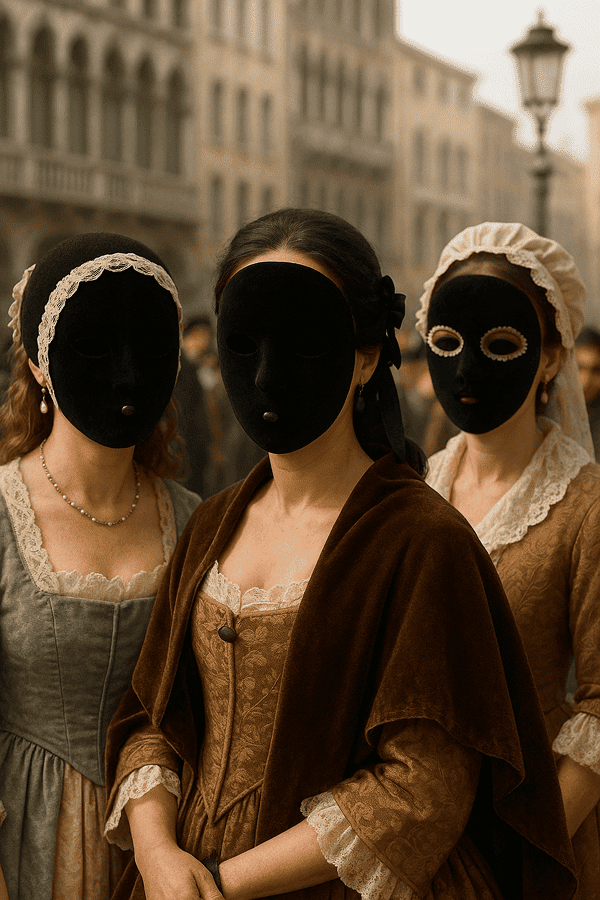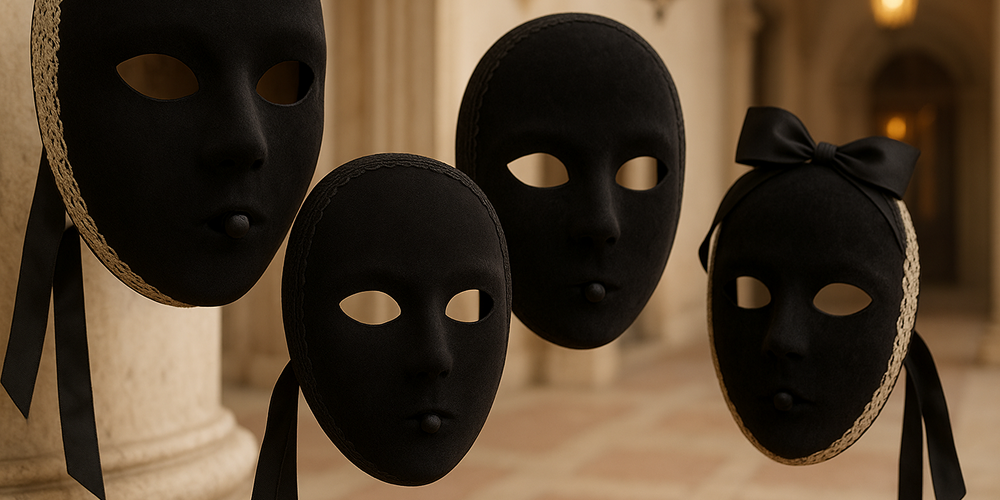The Moretta Mask is one of the most enigmatic and elegant symbols of Venetian masquerade culture. Originating in Venice, this mask is particularly known for its minimalist design and its mysterious aura. Typically oval or round in shape, the Moretta Mask is crafted in black velvet and is distinguished by its lack of mouth and the subtle, yet striking, way it conceals the wearer’s identity. Traditionally, the mask was held in place by biting a small button inside, rendering the wearer silent and enhancing the mask’s aura of secrecy. Belonging to the Venetian tradition of the 16th and 17th centuries, the Moretta Mask was especially popular among women, serving as an accessory for both social intrigue and personal empowerment.
Historical Origins: The Story Behind the Moretta Mask
The Moretta Mask first appeared in Venice during the late Renaissance, at a time when the city was a vibrant center of trade, culture, and political intrigue. Its name, “Moretta,” is derived from the Italian word for “dark” or “Moorish,” referencing the mask’s signature black velvet covering. The mask’s design was inspired by similar French masks but quickly became a uniquely Venetian accessory. The Moretta Mask was worn primarily by noblewomen during public events, private gatherings, and especially during Carnival. Over time, its use evolved, becoming a symbol of mystery, seduction, and silent communication. Historical paintings, engravings, and writings from the era frequently depict women in Moretta Masks, highlighting their role in Venetian society. Notably, alongside the Moretta Mask, the Volto Mask also played a significant part in the city’s masking tradition.
Cultural Significance and Symbolism: The Meaning of the Moretta Mask
In Venetian culture, the Moretta Mask holds deep symbolic associations with femininity, discretion, and power. The mask’s featureless black surface and lack of a mouth made it a tool for silent communication, allowing women to observe and interact without revealing their identity or emotions. This silence was both alluring and empowering, offering women a rare means of agency in a society where their voices were often restricted. The Moretta Mask was also associated with spiritual and religious rituals, being worn during certain church visits and processions as a sign of humility and modesty. Myths and legends often surround the mask, with stories of secret romances, political intrigue, and dramatic encounters at masked balls. Its use in social contexts underscored the nuanced interplay between anonymity, power, and seduction in Venetian life.
Materials and Craftsmanship: How Moretta Masks Are Made
Traditional Moretta Masks are crafted from a rigid base, often papier-mâché or light wood, and covered with rich black velvet to achieve their signature appearance. The interior is fitted with a button or bit, which must be held between the teeth, ensuring the mask remains in place and the wearer remains silent. Artisans use fine materials and careful craftsmanship to achieve the mask’s smooth, seamless finish. Decorative elements are minimal, but may include delicate lace, ribbons, or subtle embroidery. While the overall design remains consistent, some regional workshops introduced slight variations, such as different velvet textures or ornamental trims. The color black was chosen for both its elegance and its symbolic association with mystery, discretion, and introspection.
Functions and Use: Moretta Mask in Ritual and Festivity
The Moretta Mask was primarily used by Venetian women during public festivals, private gatherings, and visits to churches or convents. Its function extended beyond mere disguise; it was a statement of social position, personal autonomy, and, at times, silent protest. During Carnival, the mask allowed wearers to mingle freely, transcending class and gender boundaries, and to participate in flirtatious games of intrigue. In certain religious or ceremonial contexts, the mask symbolized humility and spiritual reflection. Over the centuries, the use of the Moretta Mask has shifted from everyday accessory to a rare, almost mythic artifact, now seen mostly in historical reenactments, museum displays, and fashion collections. Today, the mask serves as a symbol of Venetian heritage and the timeless allure of mystery.

Regional Variations: Moretta Mask Across Venice and Beyond
While the Moretta Mask is quintessentially Venetian, subtle variations in style and use emerged in different parts of the city and among neighboring regions. Some masks featured oval shapes, while others were more rounded; some included extra lace or feather adornments, though the essence of the mask always remained understated and elegant. Comparisons with other Venetian masks, such as the Volto Mask or the more flamboyant Colombina, reveal the unique restraint and sophistication of the Moretta. Unlike the elaborate masks of other European masquerade traditions, the Moretta Mask’s minimalism set it apart as a distinctly Venetian innovation.
Famous Examples and Collections: Where to See Moretta Masks
Significant examples of the Moretta Mask can be found in renowned museums such as the Museo di Palazzo Mocenigo and the Ca’ Rezzonico in Venice, where historical masks and costumes are preserved and displayed. Antique Moretta Masks are occasionally found in private collections and at European auction houses, often accompanied by detailed provenance and historical documentation. Artifacts and engravings from the 17th and 18th centuries offer additional insight into the mask’s cultural role. For those eager to learn more, websites like toddmasks.com provide curated galleries and educational resources on Venetian masks, including rare and reproduction Moretta Masks.
Influence on Art and Culture: The Moretta Mask’s Legacy
The Moretta Mask has left a lasting imprint on literature, art, and popular culture. Its enigmatic silhouette appears in paintings, novels, films, and even modern fashion, where designers are inspired by its blend of secrecy and elegance. The mask’s silent mystery has been referenced in works exploring themes of identity, gender, and social boundaries. In contemporary design, the Moretta Mask continues to inspire jewelry, accessories, and haute couture collections. Its presence in exhibitions and cultural events ensures that the story of the Moretta remains alive, contributing to the preservation of Venetian tradition and the global fascination with masquerade art.
Modern Status and Preservation: Keeping the Moretta Mask Tradition Alive
Today, the art of making Moretta Masks is maintained by a small number of Venetian artisans dedicated to preserving traditional techniques. Cultural organizations, museums, and educational programs in Venice support the transmission of mask-making skills through workshops, masterclasses, and public demonstrations. Modern adaptations may include the use of new materials, but authentic craftsmanship remains central to the mask’s identity. Festivals and exhibitions celebrating Venetian masquerade continue to feature the Moretta Mask, ensuring its relevance for new generations of artists, performers, and enthusiasts.
Collecting and Acquisition: Acquiring Authentic Moretta Masks
The market for Moretta Masks is specialized, with authentic examples available from traditional Venetian mask shops, specialty galleries, and reputable online sources such as toddmasks.com. Prices vary depending on age, craftsmanship, provenance, and rarity, with antique masks commanding higher values. Prospective buyers should look for documentation of authenticity and understand the ethical aspects of collecting cultural artifacts. Supporting local artisans and ethical sourcing ensures the preservation of Venice’s rich mask-making heritage.
